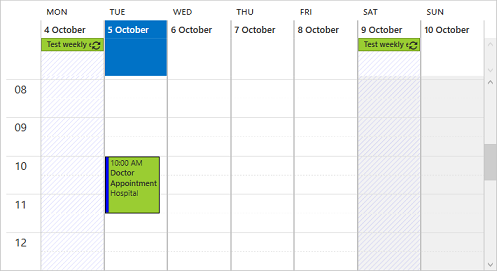Quick Start
The following quick start guide is intended to get you up and running with Scheduler for WPF. In this quick start you'll create a new Expression Blend project, add Scheduler to your application, bind to a data source, and customize the schedule.
Note: In this quick start guide you will use the C1NWind.mdb database installed by default to Documents\ComponentOne Samples\Common.
Set up the Application
Create a new WPF App in Visual Studio.
Drag and Drop the C1Scheduler control from the toolbox onto the UI Designer Window. The following references automatically get added to the References.
C1.WPF.Schedule
C1.WPF
or
Add the NuGet packages by following these steps:
In the Solution Explorer, right click Dependencies and select Manage NuGet Packages.
In NuGet Package Manager, select nuget.org as the Package source.
Search and select the following package and click Install.
C1.WPF.Schedule
In the XAML Editor and add name for the Scheduler control using the following code:
<c1:C1Scheduler x:Name="scheduler"></c1:C1Scheduler>Configure the Data Source
In the Solution Explorer, right-click on the project and select Add | New Item.
In the Add New Item dialog, select Data from the installed templates pane, select DataSet from the middle pane and click Add.
From the View menu, select Server Explorer to open it.
Right-click on the DataCollections and select Add Connection.
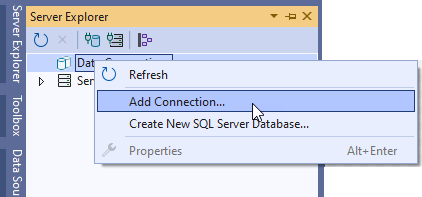
From the Choose Data Source dialog, select Microsoft Access Database File and click Continue.
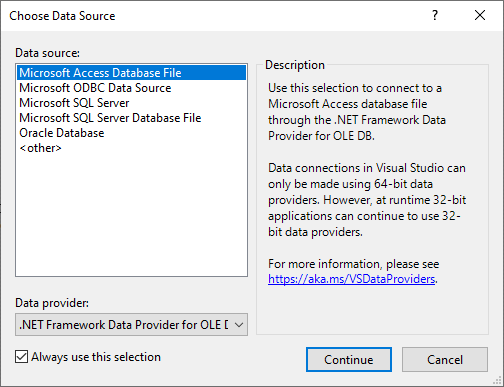
In the Add Connection dialog, browse and select the C1NWind.mdb file, enter your username and password, and and click the Advanced button available towards the bottom-left.
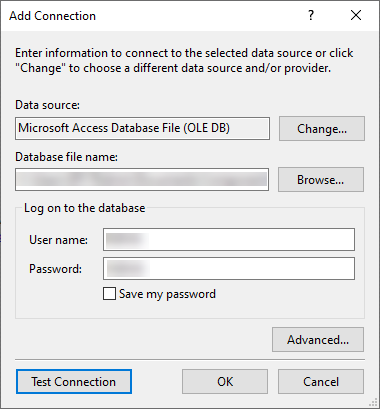
In the Advanced Properties dialog, navigate to the Provider property and change the Provider to Microsoft.ACE.OLEDB.12.0 and click OK. Observe that a new connection will be added under ServerExplorer | DataConnections.
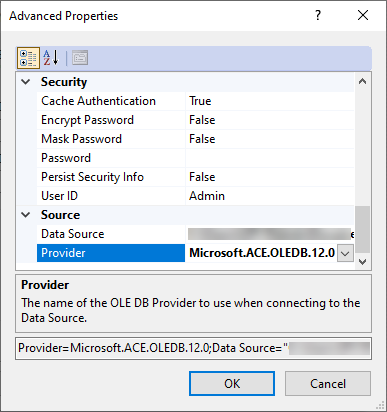
Note: In case you have a 32-bit system with .NET Framework API, please select Microsoft.Jet.OLEDB.4.0 as a provider in this step.
In the Solution Explorer, double-click the added DataSet.xsd file, say DataSet1, to open the designer.
Expand the DataConnections | Tables and drag-drop a table, say Appointees, to the designer.
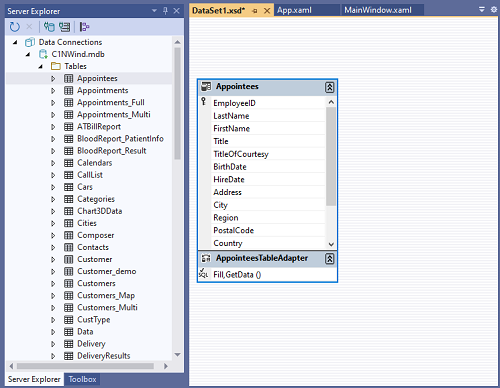
Switch to the code view and add the following using statements:
using C1.C1Schedule;
using System.Windows.Controls;
using ProjectNAME.C1NWindDataSetTableAdapters;
Note that the using statement should contain the name of your project in order to work correctly. It will be used to set up the table adapter for your data set. The Imports statement should be used for Visual Basic projects.
Add the following code to use the data from the dataset to fill the scheduler.
public partial class MainWindow : Window
{
private AppointmentsTableAdapter _appointmentsTableAdapter;
private AppointeesTableAdapter _appointeesTableAdapter;
private C1NwindDataSet _dataSet;
public C1NwindDataSet DataSet => _dataSet;
public MainWindow()
{
InitializeComponent();
_dataSet = new C1NwindDataSet();
_appointeesTableAdapter = new AppointeesTableAdapter();
_appointmentsTableAdapter = new AppointmentsTableAdapter();
_appointmentsTableAdapter.Fill(_dataSet.Appointments);
_appointeesTableAdapter.Fill(_dataSet.Appointees);
}
}
Bind Scheduler to the Data Source
Map the database to the Appointment Storage by adding the following XAML code between the <c1:C1Scheduler></c1:C1Scheduler> tag or adding the following C# code in the MainWindow() constructor:
c1:NestedPropertySetter PropertyName="DataStorage.AppointmentStorage.DataMember" Value="Appointments"/>
<c1:NestedPropertySetter PropertyName="DataStorage.AppointmentStorage.DataSource" Value="{Binding DataSet, RelativeSource={RelativeSource AncestorType=local:DataSourceBinding, Mode=FindAncestor}}"/>
<c1:NestedPropertySetter PropertyName="DataStorage.AppointmentStorage.Mappings.Body.MappingName" Value="Body"/>
<c1:NestedPropertySetter PropertyName="DataStorage.AppointmentStorage.Mappings.End.MappingName" Value="End"/>
<c1:NestedPropertySetter PropertyName="DataStorage.AppointmentStorage.Mappings.Location.MappingName" Value="Location"/>
<c1:NestedPropertySetter PropertyName="DataStorage.AppointmentStorage.Mappings.Start.MappingName" Value="Start"/>
<c1:NestedPropertySetter PropertyName="DataStorage.AppointmentStorage.Mappings.Subject.MappingName" Value="Subject"/>
<c1:NestedPropertySetter PropertyName="DataStorage.AppointmentStorage.Mappings.AppointmentProperties.MappingName" Value="Properties"/>
<c1:NestedPropertySetter PropertyName="DataStorage.AppointmentStorage.Mappings.IdMapping.MappingName" Value="Id"/>
<c1:NestedPropertySetter PropertyName="DataStorage.AppointmentStorage.Mappings.IndexMapping.MappingName" Value="N/A"/>
// set mappings and DataSource for the ContactStorage
ContactStorage cstorage = scheduler.DataStorage.ContactStorage;
cstorage.Mappings.IndexMapping.MappingName = "EmployeeID";
cstorage.Mappings.TextMapping.MappingName = "FirstName";
cstorage.DataMember = "Appointees";
cstorage.DataSource = _dataSet.Appointees;
// set mappings and DataSource for the AppointmentStorage
AppointmentStorage storage = scheduler.DataStorage.AppointmentStorage;
storage.Mappings.AppointmentProperties.MappingName = "Properties";
storage.Mappings.Body.MappingName = "Body";
storage.Mappings.End.MappingName = "End";
storage.Mappings.IdMapping.MappingName = "Id";
storage.Mappings.Location.MappingName = "Location";
storage.Mappings.Start.MappingName = "Start";
storage.Mappings.Subject.MappingName = "Subject";
storage.DataMember = "Appointments";
storage.DataSource = _dataSet.Appointments;
DataContext = this;
Run the Application
Now that you've created a scheduler application and bound the schedule to a data source, the only thing left to do is run the application.
To run the schedule application and observe Scheduler for WPF's run-time behavior:
Press F5 or select Test Solution from the Project menu. The schedule and a Reminder dialog box appears. Click Dismiss All.
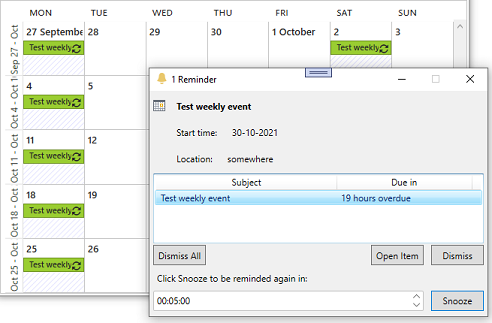
Set up an appointment by double-clicking the time for the appointment under the desired day and time. In this example, create an appointment for 10AM on Tuesday, October 5th. The Appointment dialog box opens.
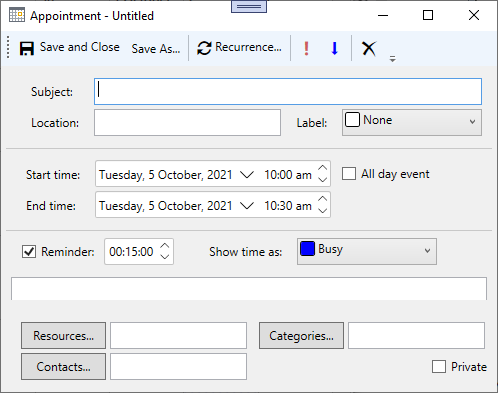
Enter “Doctor Appointment” for the Subject, “Hospital” for the Location, and “11:00AM” for the End time.
Click the drop-down arrow next to the Label and select Personal.
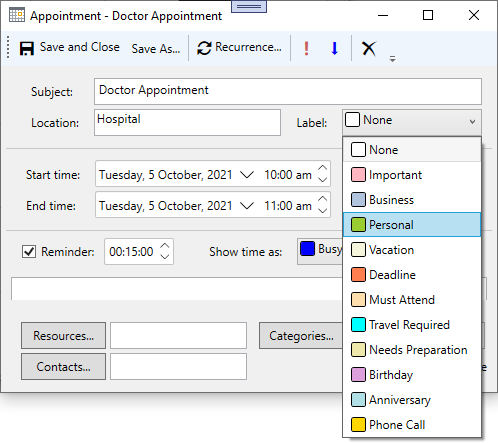
Click the Save and Close button. The appointment now appears in the schedule.
